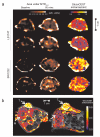In vivo imaging of glucose uptake and metabolism in tumors
- PMID: 23832090
- PMCID: PMC5275770
- DOI: 10.1038/nm.3252
In vivo imaging of glucose uptake and metabolism in tumors
Abstract
Tumors have a greater reliance on anaerobic glycolysis for energy production than normal tissues. We developed a noninvasive method for imaging glucose uptake in vivo that is based on magnetic resonance imaging and allows the uptake of unlabeled glucose to be measured through the chemical exchange of protons between hydroxyl groups and water. This method differs from existing molecular imaging methods because it permits detection of the delivery and uptake of a metabolically active compound in physiological quantities. We show that our technique, named glucose chemical exchange saturation transfer (glucoCEST), is sensitive to tumor glucose accumulation in colorectal tumor models and can distinguish tumor types with differing metabolic characteristics and pathophysiologies. The results of this study suggest that glucoCEST has potential as a useful and cost-effective method for characterizing disease and assessing response to therapy in the clinic.
Figures





Comment in
-
Imaging: Novel glucose uptake imaging method.Nat Rev Clin Oncol. 2013 Sep;10(9):488. doi: 10.1038/nrclinonc.2013.130. Epub 2013 Jul 16. Nat Rev Clin Oncol. 2013. PMID: 23856747 No abstract available.
References
-
- Ward KM, Balaban RS. Determination of pH using water protons and chemical exchange dependent saturation transfer (CEST) Magn Reson Med. 2000;44:799–802. - PubMed
-
- Kelloff GJ, et al. Progress and promise of FDG-PET imaging for cancer patient management and oncologic drug development. Clin Cancer Res. 2005;11:2785–2808. - PubMed
-
- Chan KW, et al. International Society for Magnetic Resonance in Medicine. Montreal: 2011. Imaging of glucose uptake in breast tumors using non-labeled D-glucose.
-
- Walker-Samuel S, Johnson SP, Pedley RB, Lythgoe MF, Golay X. International Society for Magnetic Resonance in Medicine. Montreal: 2011. Assessment of tumour glucose uptake using gluco-CEST.
-
- El Emir E, et al. Predicting response to radioimmunotherapy from the tumor microenvironment of colorectal carcinomas. Cancer research. 2007;67:11896–11905. - PubMed

